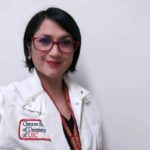Common viruses that can be present in the oral cavity are Herpes Simplex 1 and 2. Herpes Simplex Virus Type 1 (HSV-1) is spread predominantly through infected saliva or active perioral lesions. HSV-1 is adapted best and performs more efficiently in the oral, facial, and ocular areas. The pharynx, intraoral sites, lips, eyes, and skin above the waist are involved most frequently [1[.
Like what you’re learning? Download a brochure for our online, postgraduate Oral Pathology and Radiology degree program.
Herpes Simplex Virus Type 2 (HSV-2) is adapted best to the genital area, is transmitted predominantly through sexual contact, and typically involves the genitalia and skin below the waist. Exceptions to these rules occur, however, and HSV-1 can be seen in a pattern similar to HSV-2 and vice-versa. The clinical lesions produced by both types are identical, producing the same changes in the tissue [1].
Who is at risk?
It is estimated that almost 90% of the world’s population is seropositive for HSV-1 by 35 years of age, and half of the individuals carrying the virus will experience reactivation in the form of herpes labialis. Herpetic gingivostomatitis is equally distributed amongst gender and race groups and is not found to have a particular seasonal or geographic distribution [2].
What is the Clinical Presentation?
HSV-1 symptoms may include a prodrome of fever, followed by mouth lesions with submandibular and cervical lymphadenopathy. The mouth lesions (Figure 1.) consist of painful blisters on a red, swollen base that occur on the lips, gingiva, oral palate, or tongue. The lesions ulcerate, and the pain can be severe. Refusal to eat or drink may be a clue to the presence of oral HSV. The lesions usually heal within 10 to 14 days.
HSV-2 may present as a primary infection with painful genital ulcers, sores, crusts, tender lymphadenopathy, and dysuria. The classical features are macular or papular skin and mucous membrane lesions progressing to vesicles and pustules that often last up to 3 weeks. Genital lesions can be especially painful, leading to swelling of the vulva in women, burning pain, and dysuria [3].

Figure 1. A and B show herpetiform presentation of HSV 1. Photo credits Usatine RP et al. [4]
How can it be transmitted?
Both HSV-1 and HSV-2 are highly contagious and can be transmitted through direct contact with an infected person’s sores or through oral, genital, or anal mucous membranes [5].
What are the treatment options?
While there is no cure for herpes, antiviral medications can help manage and reduce the severity and frequency of outbreaks. These medications may also reduce the risk of transmission. Additionally, topical anesthetics may be incorporated into the treatment for pain management. Some of the treatment options are listed below:
- Xylocaine 2% Viscous
- Magic Mouth Wash (1 part viscous lidocaine 2%, 1 part diphenhydramine 12.5mg/5ml, 1 part Maalox)
- Acyclovir 200mg; Disp 50 to 60 capsules. Take 1 capsule 5 times per day for 7 days.
- Valacyclovir 1000mg; Disp 20 tablets. Take 1 tablet 2 times per day for 7 days (not indicated for HIV patients due to the risk of thrombocytopenia).
- Famciclovir 250mg; Disp 30 tablets. Take 1 tablet 3 times per day for 7 days.
Reactivation of the Virus: Recurrence?
During their first infection, people may experience fever, body aches, sore throat (oral herpes), headache, and swollen lymph nodes near the infection, and the HSV can enter the terminal axons of neurons that innervate tissue at the initial site of infection. Although viral genomes are most frequently detected in sensory ganglia, particularly the trigeminal ganglia (HSV-1) and lumbar-sacral ganglia (HSV-2) [6].
Reactivation of HSV 1 can establish latency in the trigeminal ganglion and cause clinical signs and symptoms associated with several cranial nerves. Reactivation of HSV 2 in adults can remain dormant in sacral nerve root ganglia infection, and lesions can affect many organs in the body (6). People can have repeated outbreaks over time (‘recurrences’). These are usually shorter and less severe than the first outbreak [5].
What are the complications?
- Ocular Infections, such as scarring of the cornea that may lead to blindness
- Oropharyngeal infections
- Eczema herpetic
- Herpetic whitlow
- Visceral infections resulting from viremia
- Encephalitis
- Meningitis
- Bell’s palsy
- Neuritis, among others
If viral infections are left untreated, they could progress to complications such as coma and death.
Conclusion
The transmission of HSV can be reduced by avoiding contact with potential virus-shedding lesions, safe sexual practices, and antiviral therapy before complications. Significant research for a potential vaccine is ongoing and offers hope for the future.
Postgraduate Oral Pathology and Radiology Degree
Learn more about the clinical and didactic skills necessary to evaluate and manage patients with oral diseases by enrolling in Herman Ostrow School of USC’s online, competency-based certificate or master’s program in Oral Pathology and Radiology.
References:
- Neville B.W, Damm D.D, Allen C.M, Bouquot, J.E Oral and Maxillofacial Pathology, 3rd ed. St Louis: Elsevier-Saunders. 2009; St Louis: Elsevier.
- Minira Aslanova; Rimsha Ali; Patrick M. Zito. (2023). Herpetic Gingivostomatitis. Herpetic Gingivostomatitis.
- Mathew Jr J, Sapra A. Herpes Simplex Type 2. [Updated 2023 Aug 7]. In: StatPearls [Internet]. Treasure Island (FL): StatPearls Publishing; 2023 Jan-
- Usatine RP, Tinitigan R. Nongenital herpes simplex virus. American Family Physician. 2010 Nov 1;82(9):1075-82. PMID: 21121552
- World Health Organization. (2023, April 5). Herpes Simplex Virus. Retrieved from World Health Organization.
- Jon B. Suzich, A. R. (2018). Strength in diversity: Understanding the pathways to herpes simplex virus. Virology, 11.


